What counts as a big player? Those who have made a lot of money usually won't talk, while those with skills who become instructors will definitely say they made money. In my view, the market is always changing, but the rules remain the same. Your only goal is to not get washed out in this great wave of sand. If you feel confused, it might be a good idea to bookmark this article as the starting point of your trading journey. It’s not about getting rich quickly, but about staying in the game!
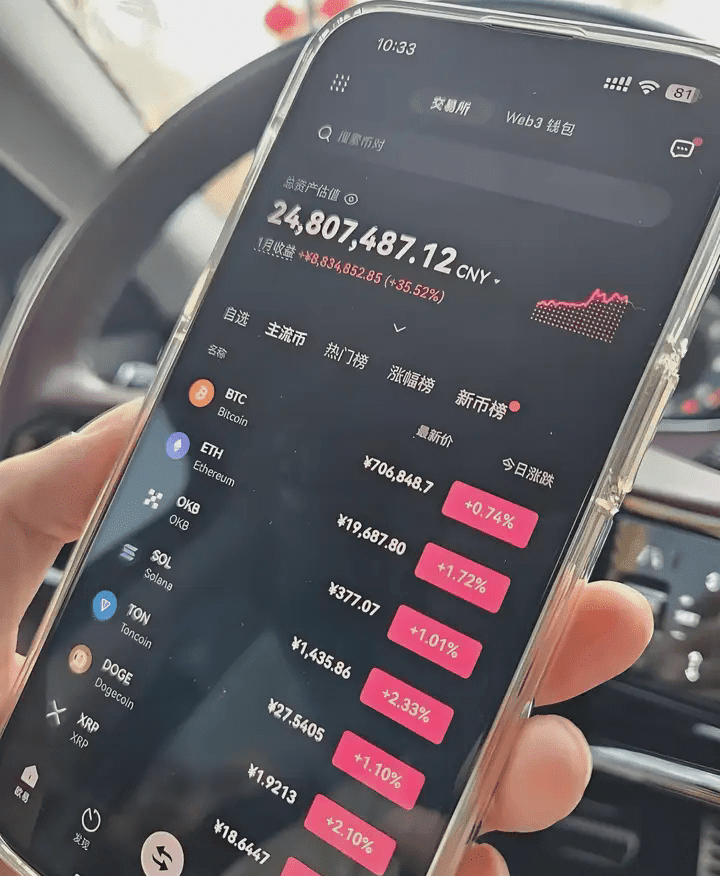
If you also want to enter the crypto world, take a look at the following content; it will help you
1. What is Currency Trading? First Understand the Underlying Logic
Many people think trading cryptocurrencies is mysterious, but it's actually quite similar to 'stock trading' or 'shoe trading'; the core is four words: buy low, sell high. For instance, if you think Bitcoin will rise, buy one at $30,000, and sell it when it rises to $40,000, you earn $10,000 (about 70,000 RMB). However, compared to traditional investments, the crypto market has two major characteristics:
24-hour trading: No market closure, can operate overnight price fluctuations, suitable for night owls (but can also easily lead to insomnia)
Unlimited price fluctuations: It’s not uncommon for prices to double or halve in a day, so be cautious if you have a weak heart.
2. How to Choose an Exchange? Remember Three Life-Saving Principles
The exchange is the 'market' for buying and selling coins; choosing the wrong one may lead to total loss. Newbies remember:
Choose only top platforms: Binance, OKX, Huobi, prioritize OKX for domestic users (supports WeChat/Alipay deposits, the interface is fully in Chinese, very friendly for beginners)
Don't mess with small exchanges: Some platforms attract you with '100% rebate', but when they run away, the customer service doesn't respond.
Complete identity verification: Although it’s troublesome, it unlocks higher limits and functions, equivalent to insurance for your account.
3. USDT - The 'Food Ticket' of the Crypto World
One of the most confusing points for newcomers: You cannot directly buy Bitcoin with RMB! You must first use RMB to buy USDT (1 USDT ≈ 1 dollar). It's like exchanging chips in a casino; USDT is the 'universal chip' in the crypto world.
Three Major Channels to Buy USDT:
① OKX C2C Area: Choose merchants that use 'Alipay payment' + '99% transaction rate', funds arrive in 5 minutes
② Binance Fast Buy: Suitable for small amounts, but the minimum single transaction is 500 yuan
③ Friend Transfer: The safest is with acquaintances, but be careful of encountering fake USDT
4. 30 Essential Slang Terms You Must Understand (Guide to Avoiding Losses)
Understand these, and you won't be fooled by the old veterans:
Position Management: Full Position (All In), Half Position (Leave a Way Out), Empty Position (Wait and See)
Operational Strategies: Take Profit (Run When You Earn), Stop Loss (Exit When It Hurts), Induce More (False Rise to Fool You Into Buying)
Market Judgment: Bull Market (Rising Every Day), Bear Market (Declining to the Point of No Recognition), Spike (Sudden Price Drops and Rises)
5. Newbie Self-Sabotage Behavior Ranking
Use hard-earned experience to help you avoid pitfalls:
❗ First Place: Playing Contract Leverage
10 times leverage to gain 10%? A 10% drop leads to liquidation! I've seen too many people lose half a year's salary in one night.
❗ Second Place: All in on Dirt Dog Coin
What is 'Dogecoin Killer' and 'Moon Coin', the calls in the group are all shills, once you buy in they withdraw
❗ Third Place: Follow the Trend and Bet Big
Did you enter the market only after seeing news of 'Bitcoin Soaring'? Congratulations, you likely bought at the highest point.
These experiences are summarized from my actual trading, playing a key role in cultivating the correct trading mindset and way of thinking. I hope that by sharing these experiences, I can help more novice traders who have just stepped into the trading world or traders fighting in the market achieve better trading performance and reduce unnecessary troubles.
Every trade is a battle.
On the battlefield, even the greatest general must make a temporary tactical retreat; in the market, we must also withdraw temporarily.
On the battlefield, the commander’s slight retreat aims to preserve troops and ammunition. Our goal is to save funds and maintain a balanced mindset. Sometimes, you must lose a few battles first to win the final victory.
As the Japanese say, 'As long as you can catch salmon, losing a few hooks is worth it.' If you are stopped out, consider it losing a hook. Maybe the next catch will be a big one.
Today, I will share a very key point that most people overlook:
How to take profits and stop losses after entering
Both profit-taking and stop loss are exit strategies. In other words, it is about how to exit reasonably after entering. This is a very important and key technique.
If you trade or invest without exiting, for instance, if you bought Bitcoin for $5,000 three or four years ago when the price was very low. After holding for two to three years, you may have gained more than ten times returns. However, if you didn’t sell at the peak and continued to hold until now, your originally very high annualized return would have significantly shrunk.

For example, earning ten times in two to three years, if you don’t exit in time, as the market declines, your annualized returns will become very small. Therefore, reasonably taking profits and stopping losses, and exiting in a timely manner is key to ensuring investment returns.

LUNAS
If you bought Bitcoin, at least you are still making money. However, if you bought many altcoins, even if you earned hundreds of times during the holding period, if you did not sell in time, in the end, you may fall back into losses, even suffering large losses. This further highlights the importance of reasonable exits.
Plan your profit-taking and stop-loss strategy
In trading or investing, we need to have expectations and a bottom line. When we enter at a price point, if the price rises to the expected position, we should exit; if the price falls to our bottom line, we should also exit.
There are many reasons for stop loss. It may be that the loss amount has reached our risk control level, so we need to exit. It could also be that the market trend proves our actions and judgments are incorrect, and we need to quickly acknowledge the mistake and stop loss. Profit-taking and stop loss are equally important.
Even Warren Buffett, who widely encourages value investing, chooses to exit during periods of major bubbles in long cycles, holding a lot of cash. Therefore, whether it is profit-taking or stop-loss, timely exit is a very key and important technical ability. This principle applies to both fundamental and technical analysis.
Next, I will introduce 4 common stop loss methods and 4 common profit-taking methods.
4 Common Stop Loss Strategies
1. ATR Stop Loss
Setting a stop loss based on market volatility is a common and effective method, especially suitable for left-side order traders and breakout traders. Here are the specific applications of ATR (Average True Range) stop loss strategy:
Pullback Orders and ATR Stop Loss
In forex trading, pullback trading is a very common practice. Traders enter directly when the price pulls back to a certain position, predicting subsequent trends through moving averages, and placing orders at the moving average position. At this point, ATR stop loss can be used to set reasonable stop loss levels.
Specific operational steps:
1. Entering with an order: find the moving average and predict that the price will continue along it. Place an order at the moving average position. 2. Set ATR stop loss after entry; check the ATR value. For example, if the ATR is 0.6, you can use 2 times or 3 times ATR, which is 1.2 or 1.8 as the stop loss.
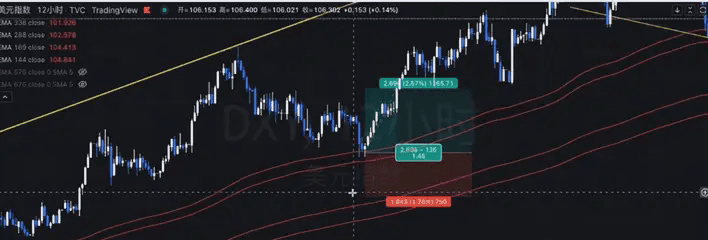
Example: Use 3 times ATR as a stop loss at the entry point; 0.6*3=1.8
If the stop loss is set wider (like 1.8 times ATR), the win rate will be higher; if the stop loss is set narrower (like 1.2 times ATR), the profit-loss ratio will be higher. This depends on personal habits and trading styles. Generally, an ATR multiple between 2-4 is more appropriate.
Breakout trading and ATR stop loss
ATR stop loss also applies to breakout trades. Especially in the bull market for Bitcoin, go long whenever a new high is reached or a structure is broken, but this must be done in a bull market.
Specific operational steps:
1. Order Breakthrough: In Bitcoin, place an order to go long whenever a new high is reached or a structure is broken. It is necessary to confirm that the market is in a bull phase to avoid meaningless order operations in a bear market. 2. Set ATR stop loss. For example, check the ATR value during the breakout. If the ATR is 3,000, then two times ATR would be 6,000, and you can set a stop loss of 6,000 based on two times ATR.
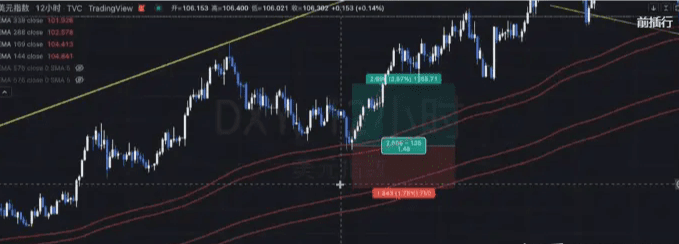
Profit-taking can be set to 2 times or 4 times ATR, depending on your trading system strategy.
Profit-taking strategies and profit-loss ratios
If you want a higher profit-loss ratio, you need to sacrifice win rate; if you want a lower profit-loss ratio, profit-taking is easier but hard to make big money.
Mature traders usually make big money by frequently accumulating small profits rather than relying on single trades. For example, holding to target with a fixed profit-loss ratio is a very common and effective trading method.
2. Key Point Stop Loss
The principle of key point stop loss is: when going long, set the stop loss below the support level; when going short, set the stop loss above the resistance level after entry.
For example, in a bearish trend. Suppose we see a double top in the long-term daily chart, while the corresponding shorter timeframe shows a three-push wedge shape. Although the structures of the larger and smaller timeframes seem different, the key positions are quite similar. On the smaller timeframe, this is a three-push pattern, breaking below the key position; on the larger timeframe, this is a double top pattern, breaking below the top line. Therefore, when we short here, we can set the stop loss at the key position above.
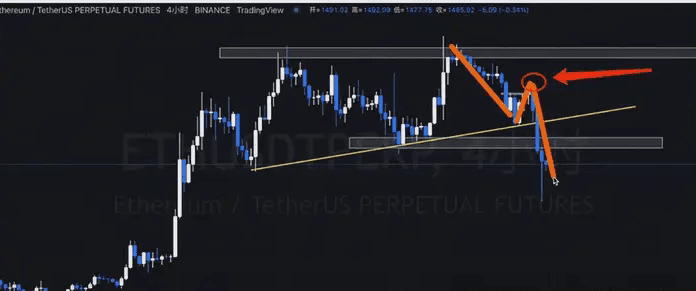
When trading in a bull market, you can set the stop loss at a key point below. Stop losses in a bull market are generally more lenient than in the current bear market, because a bull market has a continuous upward momentum. Breakdowns in a bull market often fail, and a bearish candle is usually followed by a bullish candle. Therefore, in a bull market, my stop loss would be set below a key price level ahead.
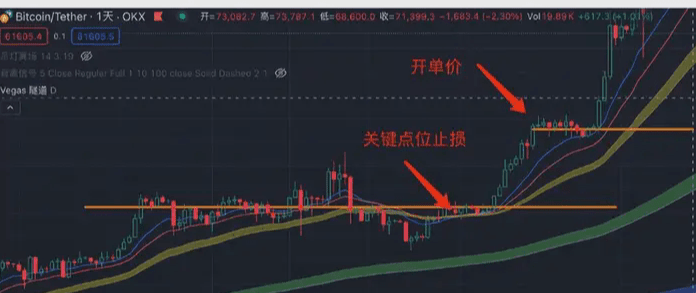
In a bear market, it is recommended to set a narrower stop loss. But in a bull market, you can also take another aggressive stop loss, for example, after getting a long position, set the stop loss below double the moving average. If the entry was at the 2-hour moving average, then the stop loss can be below the 4-hour Vegas, as this is a good support level. If the price continues to range, it may touch the moving average.
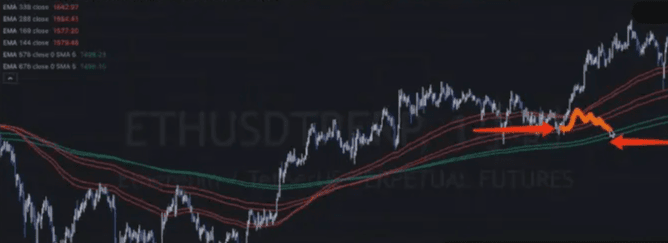
This strategy is not applicable in a bear market, but only in a bull market, because downturns in a bull market are often failures, with a bearish candle followed by a bullish candle.
3. Time Stop Loss
The time stop loss strategy is to immediately stop loss if there is no profit after holding for a certain time. This is a very practical method.
This method is often used in short-term and swing trading. The author of the book 'Wall Street Ghost' actually recommends a similar method. 'Wall Street Ghost' discusses intraday trading. In intraday trading, if you don't see a profit a few minutes after entering, just exit. Although this method may lead to a lower win rate, wrong trades often won't incur losses. If the price ranges for a few minutes after entry, exit; if the price is profitable, continue to hold. This is a very simple yet effective method.
In swing trading, you can set a time limit, such as if there is no profit after 4 hours of entering, you should stop loss and exit. If you're trading on a larger timeframe, you can set a 10-day time limit. If there is no profit after 10 days of entry, exit. This is a very good method but requires a lot of chart analysis skills.
For example, if you're trading Bitcoin, you should be familiar with the trends on charts longer than 30 minutes, reviewing data from the past 5 years, including 30-minute, hourly, 4-hour, and daily charts. It's crucial to remember the approximate prices and patterns for each day. Your memory of the overall trends and historical patterns will become your advantage.
4. Fixed Stop Loss
The 'Fixed Amount Stop Loss' strategy is rarely used in futures short-term trading but is very common in stock and spot trading. Specifically, when you buy stocks, regardless of market trends, as long as the stock falls by a fixed percentage, such as 10%, 20%, or 25%, you will immediately stop loss and exit, without considering market patterns or other factors.
This method does not consider other factors in the market; it only looks at whether the decline has reached the preset stop-loss point. It is very common in stock and spot trading, and many investors use this method to control risk and avoid greater losses.
4 Common Profit-Taking Strategies
1. Fixed profit-loss ratio
Fixed profit-loss ratio is a commonly used strategy.
For example, if the risk of a trade is 10%, I expect to gain 20%. My profit expectation must be greater than the risk. For example, if the expected drop is 15 points, then the profit target should be set at 30 points.
As long as the preset profit-loss ratio is achieved, you should exit without considering other market fluctuations. If you want a higher profit-loss ratio, you need to bear the psychological pressure of a lower win rate. For instance, if your profit-loss ratio is 1.2 or even 1.1, then the win rate will be very high. There is a balance between profit-loss ratio and win rate. If you adopt a fixed profit-loss ratio strategy, as long as the win rate can reach the expected value, you can achieve profitability.
The following table shows the win rate needed to break even; exceeding this win rate will lead to profit (excluding handling fees)
Profit-loss ratio Win Rate 150% 1.5 40% 1.75 36.5% 2 33.3% 2.5 28.75 325% 5 16.67% 9 10% 10 9.1%
Of course, we trade not just for small advantages but to pursue greater advantages. For example, if your profit-loss ratio is 2, as long as the win rate exceeds 50%, you will have a significant advantage. Even if the profit-loss ratio is 2, with a win rate of only 40%, trading is still advantageous, but not significantly.
2. 1:1 Equal Spacing Target
This method predicts the next price movement target based on the last price fluctuation range. For instance, in structures like ranges, flags, and parallel channels, you can determine the same amplitude profit target by measuring the previous fluctuation distance.
For example, after a range breakout, we set the target as a multiple of the height of the range prior to the breakout, and the final price reached the expected target.
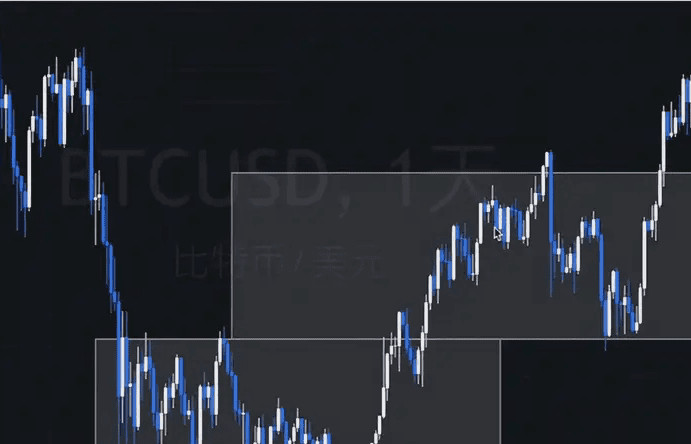
Range Equal Spacing Breakout
Similarly, this method can also be used for channels. Channels can be understood as inclined oscillation ranges, and when the range is broken, the target price is a multiple of equal spacing, which can be effective in many situations.
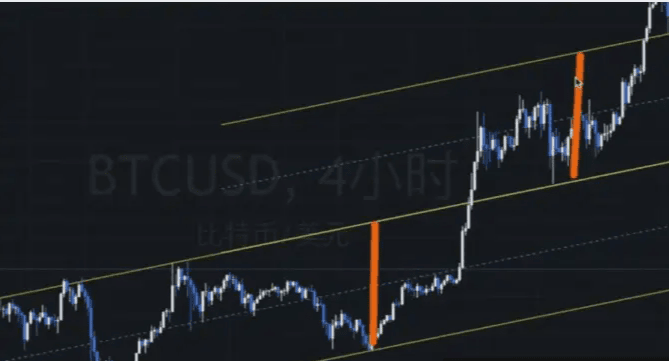
Channel Equal Spacing Breakout
For example, in a bull market, when a strong price fluctuation ends, we can use the distance from the start to the end of this fluctuation to predict the target of the next fluctuation.
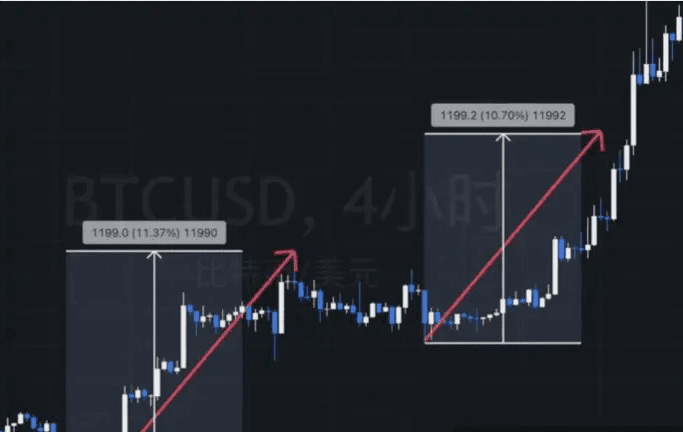
Strong Breakout 1:1 Equal Spacing
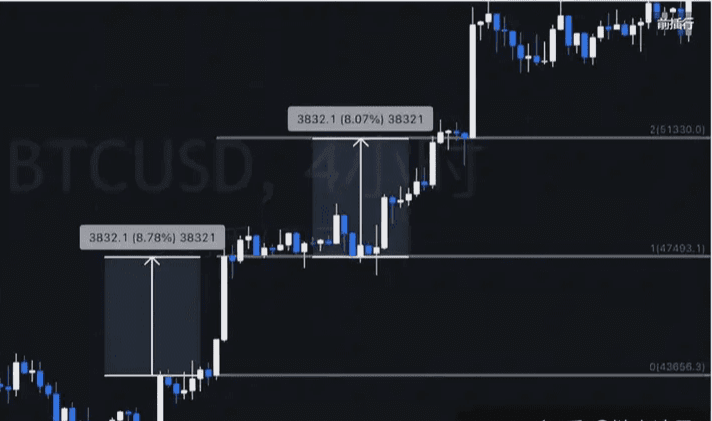
This '1:1 equal spacing' calculation method is very common, and most traders will use it.
So, which method is better compared to a fixed profit-loss ratio? It’s actually hard to say. I think as long as you consistently use a certain method, that is the best. For example, if you are used to using '1:1 equal spacing', then consistently use this method. If you prefer fixed profit-loss ratios, you should also stick to it.
The worst thing is that today you think a fixed profit-loss ratio is good, and a few days later you feel it makes you take profits too early, so you start using '1:1 equal spacing'. If you keep switching like this, your trading system won't have much advantage. The key is to stick to it.
For example, let’s look at a situation. Sometimes the price fluctuation does not reach the '1:1 equal spacing' target, only reaching 70%. If you constantly change strategies, you may fall into chaotic trading. Therefore, choosing one method and sticking to it is the most important.
3. Trailing Stop Loss
That is, every time you make a profit, move the stop loss once.
For example, if you enter at a certain point, as the price reaches new highs, gradually move the stop loss position up. If the subsequent price continues to reach new highs, keep moving the stop loss position up until you get stopped out. The advantage of trailing stop loss is that if you persistently use it over the long term, you may encounter one or two trades that create substantial profits.
However, in daily trading, it is often encountered that the money earned is given back. If you persist with this strategy, you may earn back the total of the past few years in some future trades.
This method is suitable for traders who take long trends, while short-term traders often won't use it.
Trailing stop loss is hard to stick to, but many traders use it, and the overall profit advantage is significant.
4. Hold Until Reversal
Only close the position when a reversal pattern appears. This method tests technical ability more.
You need to identify most reversal patterns; if you cannot distinguish between likely pullbacks or reversals, you cannot use this method. At the same time, predicting reversal patterns may also lead to judgment failures; failures of reversal patterns can become stronger trend-following patterns, potentially leading to greater losses.
So this method has very high technical requirements, but if you can achieve a unity of knowledge and action regarding all technical patterns and data indicators, this is a solution worth trying. Every trade is a battle.
On the battlefield, even the greatest general must make a temporary tactical retreat; in the market, we must also withdraw temporarily.
On the battlefield, the commander’s slight retreat aims to preserve troops and ammunition. Our goal is to save funds and maintain a balanced mindset. Sometimes, you must lose a few battles first to win the final victory.
As the Japanese say, 'As long as you can catch salmon, losing a few hooks is worth it.' If you are stopped out, consider it losing a hook. Maybe the next catch will be a big one.
Today, I will share a very key point that most people overlook:
How to take profits and stop losses after entering
Both profit-taking and stop loss are exit strategies. In other words, it is about how to exit reasonably after entering. This is a very important and key technique.
If you trade or invest without exiting, for instance, if you bought Bitcoin for $5,000 three or four years ago when the price was very low. After holding for two to three years, you may have gained more than ten times returns. However, if you didn’t sell at the peak and continued to hold until now, your originally very high annualized return would have significantly shrunk.

For example, earning ten times in two to three years, if you don’t exit in time, as the market declines, your annualized returns will become very small. Therefore, reasonably taking profits and stopping losses, and exiting in a timely manner is key to ensuring investment returns.
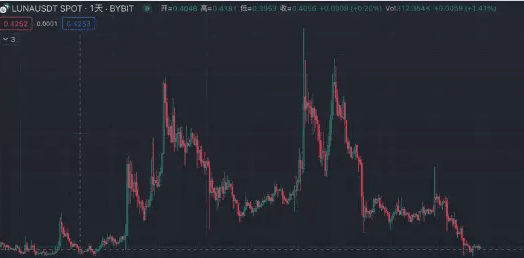
LUNAS
If you bought Bitcoin, at least you are still making money. However, if you bought many altcoins, even if you earned hundreds of times during the holding period, if you did not sell in time, in the end, you may fall back into losses, even suffering large losses. This further highlights the importance of reasonable exits.
Plan your profit-taking and stop-loss strategy
In trading or investing, we need to have expectations and a bottom line. When we enter at a price point, if the price rises to the expected position, we should exit; if the price falls to our bottom line, we should also exit.
There are many reasons for stop loss. It may be that the loss amount has reached our risk control level, so we need to exit. It could also be that the market trend proves our actions and judgments are incorrect, and we need to quickly acknowledge the mistake and stop loss. Profit-taking and stop loss are equally important.
Even Warren Buffett, who widely encourages value investing, chooses to exit during periods of major bubbles in long cycles, holding a lot of cash. Therefore, whether it is profit-taking or stop-loss, timely exit is a very key and important technical ability. This principle applies to both fundamental and technical analysis.
Next, I will introduce 4 common stop loss methods and 4 common profit-taking methods.
4 Common Stop Loss Strategies
1. ATR Stop Loss
Setting a stop loss based on market volatility is a common and effective method, especially suitable for left-side order traders and breakout traders. Here are the specific applications of ATR (Average True Range) stop loss strategy:
Pullback Orders and ATR Stop Loss
In forex trading, pullback trading is a very common practice. Traders enter directly when the price pulls back to a certain position, predicting subsequent trends through moving averages, and placing orders at the moving average position. At this point, ATR stop loss can be used to set reasonable stop loss levels.
Specific Operational Steps:
1. Entering with an order: find the moving average and predict that the price will continue along it. Place an order at the moving average position. 2. Set ATR stop loss after entry; check the ATR value. For example, if the ATR is 0.6, you can use 2 times or 3 times ATR, which is 1.2 or 1.8 as the stop loss.
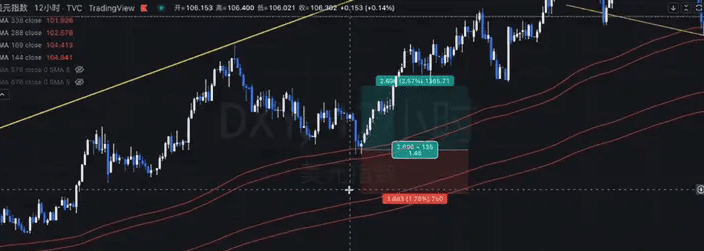
Example: Use 3 times ATR as a stop loss at the entry point; 0.6*3=1.8
If the stop loss is set wider (like 1.8 times ATR), the win rate will be higher; if the stop loss is set narrower (like 1.2 times ATR), the profit-loss ratio will be higher. This depends on personal habits and trading styles. Generally, an ATR multiple between 2-4 is more appropriate.
Breakout trading and ATR stop loss
ATR stop loss also applies to breakout trades. Especially in the bull market for Bitcoin, go long whenever a new high is reached or a structure is broken, but this must be done in a bull market.
Specific operational steps:
1. Order Breakthrough: In Bitcoin, place an order to go long whenever a new high is reached or a structure is broken. It is necessary to confirm that the market is in a bull phase to avoid meaningless order operations in a bear market. 2. Set ATR stop loss. For example, check the ATR value during the breakout. If the ATR is 3,000, then two times ATR would be 6,000, and you can set a stop loss of 6,000 based on two times ATR.
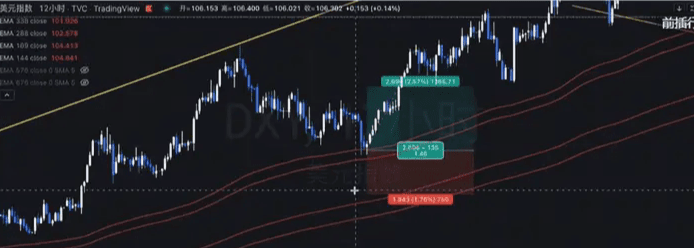
Profit-taking can be set to 2 times or 4 times ATR, depending on your trading system strategy.
Profit-taking strategies and profit-loss ratios
If you want a higher profit-loss ratio, you need to sacrifice win rate; if you want a lower profit-loss ratio, profit-taking is easier but hard to make big money.
Mature traders usually make big money by frequently accumulating small profits rather than relying on single trades. For example, holding to target with a fixed profit-loss ratio is a very common and effective trading method.
2. Key point stop loss
The principle of key point stop loss is: when going long, set the stop loss below the support level; when going short, set the stop loss above the resistance level after entry.
For example, in a bearish trend. Suppose we see a double top in the long-term daily chart, while the corresponding shorter timeframe shows a three-push wedge shape. Although the structures of the larger and smaller timeframes seem different, the key positions are quite similar. On the smaller timeframe, this is a three-push pattern, breaking below the key position; on the larger timeframe, this is a double top pattern, breaking below the top line. Therefore, when we short here, we can set the stop loss at the key position above.
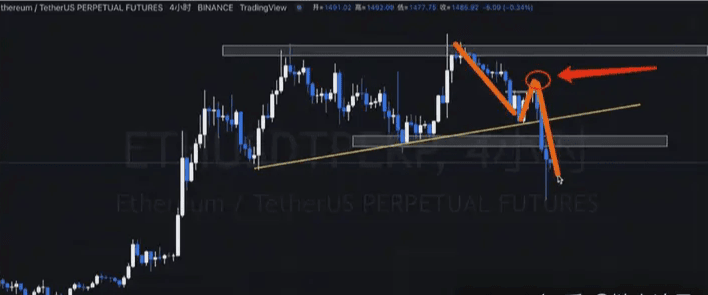
When trading in a bull market, you can set the stop loss at a key point below. Stop losses in a bull market are generally more lenient than in the current bear market, because a bull market has a continuous upward momentum. Breakdowns in a bull market often fail, and a bearish candle is usually followed by a bullish candle. Therefore, in a bull market, my stop loss would be set below a key price level ahead.
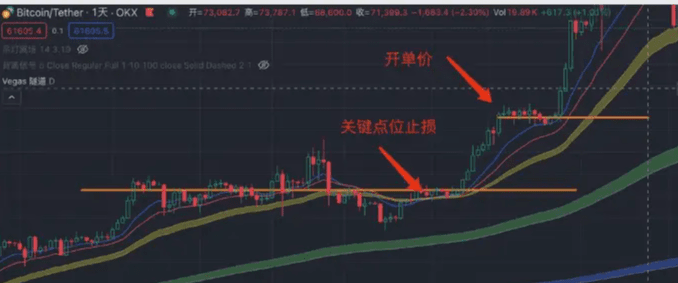
In a bear market, it is recommended to set a narrower stop loss. But in a bull market, you can also take another aggressive stop loss, for example, after getting a long position, set the stop loss below double the moving average. If the entry was at the 2-hour moving average, then the stop loss can be below the 4-hour Vegas, as this is a good support level. If the price continues to range, it may touch the moving average.
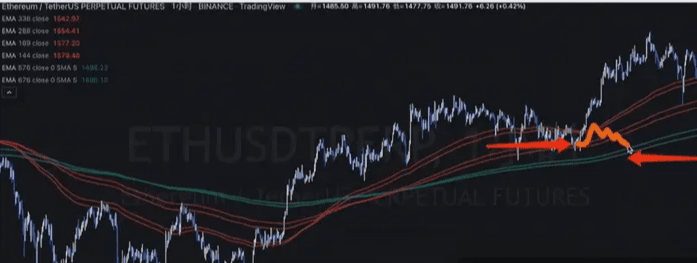
This strategy is not applicable in a bear market, but only in a bull market, because downturns in a bull market are often failures, with a bearish candle followed by a bullish candle.
3. Time Stop Loss
The time stop loss strategy is to immediately stop loss if there is no profit after holding for a certain period. This is a very practical method.
This method is often used in short-term and swing trading. The author of the book 'Wall Street Ghost' actually recommends a similar method. 'Wall Street Ghost' discusses intraday trading. In intraday trading, if you don't see a profit a few minutes after entering, just exit. Although this method may lead to a lower win rate, wrong trades often won't incur losses. If the price ranges for a few minutes after entry, exit; if the price is profitable, continue to hold. This is a very simple yet effective method.
In swing trading, you can set a time limit, such as if there is no profit after 4 hours of entering, you should stop loss and exit. If you're trading on a larger timeframe, you can set a 10-day time limit. If there is no profit after 10 days of entry, exit. This is a very good method but requires a lot of chart analysis skills.
For example, if you’re trading Bitcoin, you should at least be familiar with trends on charts longer than 30 minutes, reviewing data from the past 5 years, including 30-minute, hourly, 4-hour, and daily charts. It's crucial to remember the approximate prices and patterns for each day. Your memory of the overall trends and historical patterns will become your advantage.
4. Fixed Stop Loss
The 'Fixed Amount Stop Loss' strategy is rarely used in futures short-term trading but is very common in stock and spot trading. Specifically, when you buy stocks, regardless of market trends, as long as the stock falls by a fixed percentage, such as 10%, 20%, or 25%, you will immediately stop loss and exit, without considering market patterns or other factors.
This method does not consider other factors in the market; it only looks at whether the decline has reached the preset stop-loss point. It is very common in stock and spot trading, and many investors use this method to control risk and avoid greater losses.
4 Common Profit-Taking Strategies
1. Fixed profit-loss ratio
Fixed profit-loss ratio is a commonly used strategy.
For example, if the risk of a trade is 10%, I expect to gain 20%. My profit expectation must be greater than the risk. For example, if the expected drop is 15 points, then the profit target should be set at 30 points.
As long as the preset profit-loss ratio is achieved, you should exit without considering other market fluctuations. If you want a higher profit-loss ratio, you need to bear the psychological pressure of a lower win rate. For instance, if your profit-loss ratio is 1.2 or even 1.1, then the win rate will be very high. There is a balance between profit-loss ratio and win rate. If you adopt a fixed profit-loss ratio strategy, as long as the win rate can reach the expected value, you can achieve profitability.
The following table shows the win rate needed to break even; exceeding this win rate will lead to profit (excluding handling fees)
Profit-loss ratio Win Rate 150% 1.5 40% 1.75 36.5% 2 33.3% 2.5 28.75 325% 5 16.67% 9 10% 10 9.1%
Of course, we trade not just for small advantages but to pursue greater advantages. For example, if your profit-loss ratio is 2, as long as the win rate exceeds 50%, you will have a significant advantage. Even if the profit-loss ratio is 2, with a win rate of only 40%, trading is still advantageous, but not significantly.
2. 1:1 Equal Spacing Target
This method predicts the next price movement target based on the last price fluctuation range. For instance, in structures like ranges, flags, and parallel channels, you can determine the same amplitude profit target by measuring the previous fluctuation distance.
For example, after a range breakout, we set the target as a multiple of the height of the range prior to the breakout, and the final price reached the expected target.
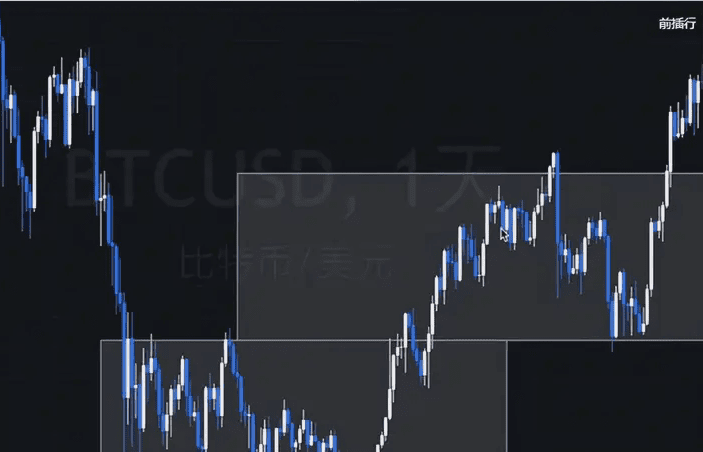
Range Equal Spacing Breakout
Similarly, this method can also be used for channels. Channels can be understood as inclined oscillation ranges, and when the range is broken, the target price is a multiple of equal spacing, which can be effective in many situations.
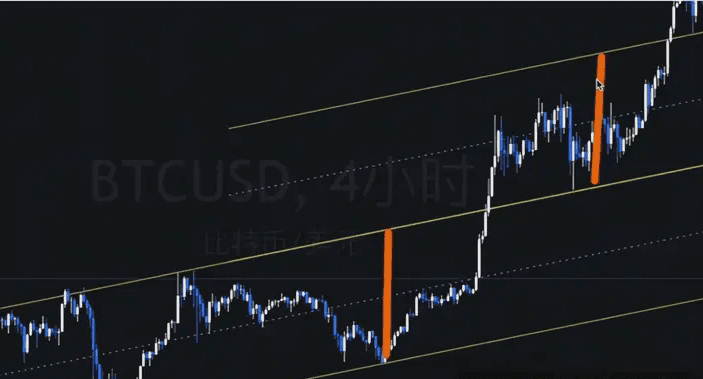
Channel Equal Spacing Breakout
For example, in a bull market, when a strong price fluctuation ends, we can use the distance from the start to the end of this fluctuation to predict the target of the next fluctuation.
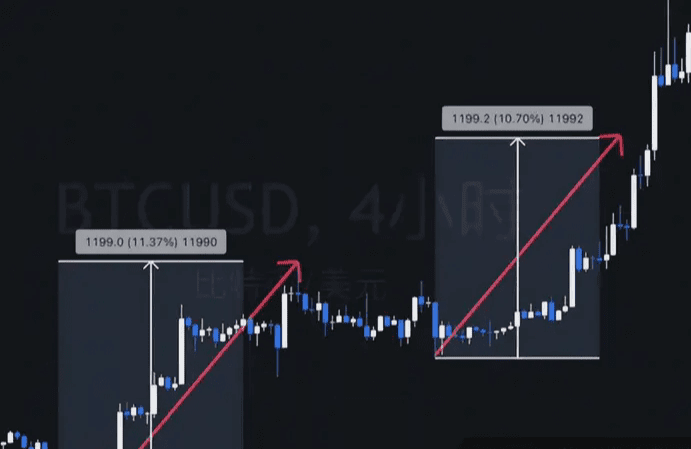
Strong Breakout 1:1 Equal Spacing
This '1:1 equal spacing' calculation method is very common, and most traders will use it.
So, which method is better compared to a fixed profit-loss ratio? It’s actually hard to say. I think as long as you consistently use a certain method, that is the best. For example, if you are used to using '1:1 equal spacing', then consistently use this method. If you prefer fixed profit-loss ratios, you should also stick to it.
The worst thing is that today you think a fixed profit-loss ratio is good, and a few days later you feel it makes you take profits too early, so you start using '1:1 equal spacing'. If you keep switching like this, your trading system won't have much advantage. The key is to stick to it.
For example, let’s look at a situation. Sometimes the price fluctuation does not reach the '1:1 equal spacing' target, only reaching 70%. If you constantly change strategies, you may fall into chaotic trading. Therefore, choosing one method and sticking to it is the most important.
3. Trailing Stop Loss
That is, every time you make a profit, move the stop loss once.
For example, if you enter at a certain point, as the price reaches new highs, gradually move the stop loss position up. If the subsequent price continues to reach new highs, keep moving the stop loss position up until you get stopped out. The advantage of trailing stop loss is that if you persistently use it over the long term, you may encounter one or two trades that create substantial profits.
However, in daily trading, it is often encountered that the money earned is given back. If you persist with this strategy, you may earn back the total of the past few years in some future trades.
This method is suitable for traders who take long trends, while short-term traders often won't use it.
Trailing stop loss is hard to stick to, but many traders use it, and the overall profit advantage is significant.
4. Hold Until Reversal
Only close the position when a reversal pattern appears. This method tests technical ability more.
You need to identify most reversal patterns; if you cannot distinguish between likely pullbacks or reversals, you cannot use this method. At the same time, predicting reversal patterns may also lead to judgment failures; failures of reversal patterns can become stronger trend-following patterns, potentially leading to greater losses.
So this method has very high technical requirements, but if you can achieve a unity of knowledge and action regarding all technical patterns and data indicators, this is a solution worth trying.
Market starts, profits double! Follow Brother Cheng to go with the trend, wealth will naturally come.
Continuous attention: SPK, C
